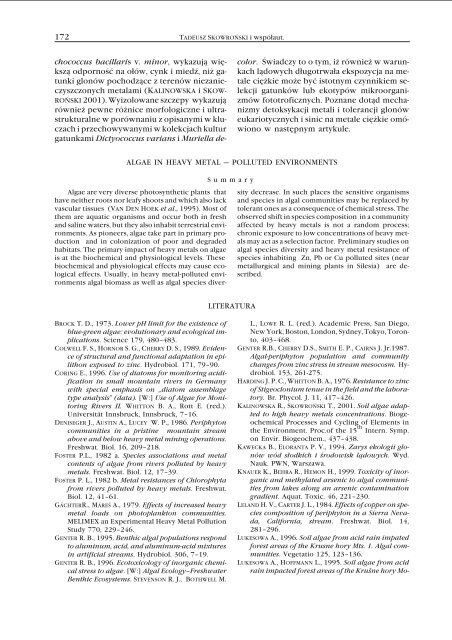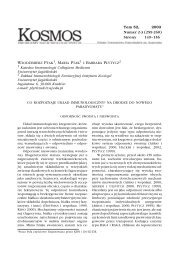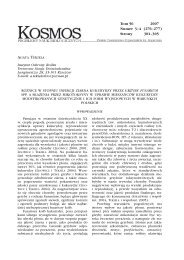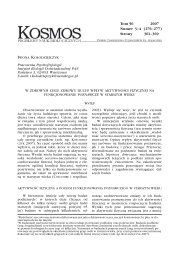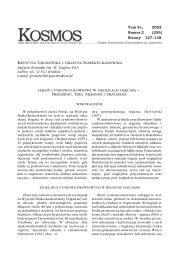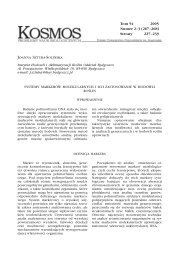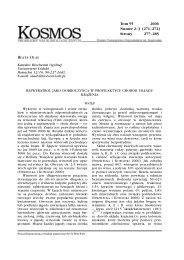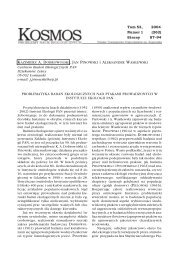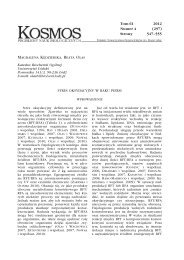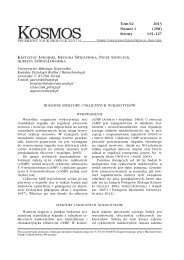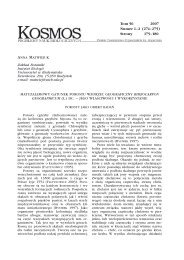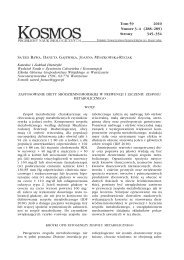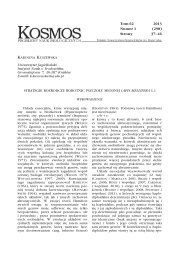TADEUSZ SKOWROŃSKI, RENATA KALINOWSKA i BARBARA ...
TADEUSZ SKOWROŃSKI, RENATA KALINOWSKA i BARBARA ...
TADEUSZ SKOWROŃSKI, RENATA KALINOWSKA i BARBARA ...
You also want an ePaper? Increase the reach of your titles
YUMPU automatically turns print PDFs into web optimized ePapers that Google loves.
172 <strong>TADEUSZ</strong> SKOWROÑSKI i wspó³aut.<br />
chococcus bacillaris v.minor, wykazuj¹ wiêksz¹<br />
odpornoœæ na o³ów, cynk i miedŸ, ni¿ gatunki<br />
glonów pochodz¹ce z terenów niezanieczyszczonych<br />
metalami (<strong>KALINOWSKA</strong> iSKOW-<br />
ROÑSKI 2001). Wyizolowane szczepy wykazuj¹<br />
równie¿ pewne ró¿nice morfologiczne i ultrastrukturalne<br />
w porównaniu z opisanymi w kluczach<br />
i przechowywanymi w kolekcjach kultur<br />
gatunkami Dictyococcus varians i Muriella de-<br />
color. Œwiadczy to o tym, i¿ równie¿ w warunkach<br />
l¹dowych d³ugotrwa³a ekspozycja na metale<br />
ciê¿kie mo¿e byæ istotnym czynnikiem selekcji<br />
gatunków lub ekotypów mikroorganizmów<br />
fototroficznych. Poznane dot¹d mechanizmy<br />
detoksykacji metali i tolerancji glonów<br />
eukariotycznych i sinic na metale ciê¿kie omówiono<br />
w nastêpnym artykule.<br />
ALGAE IN HEAVY METAL — POLLUTED ENVIRONMENTS<br />
Algae are very diverse photosynthetic plants that<br />
have neither roots nor leafy shoots and which also lack<br />
vascular tissues (VAN DEN HOEK et al., 1995). Most of<br />
them are aquatic organisms and occur both in fresh<br />
and saline waters, but they also inhabit terrestrial environments.<br />
As pioneers, algae take part in primary production<br />
and in colonization of poor and degraded<br />
habitats. The primary impact of heavy metals on algae<br />
is at the biochemical and physiological levels. These<br />
biochemical and physiological effects may cause ecological<br />
effects. Usually, in heavy metal-polluted environments<br />
algal biomass as well as algal species diver-<br />
BROCK T. D., 1973. Lower pH limit for the existence of<br />
blue-green algae: evolutionary and ecological implications.<br />
Science 179, 480–483.<br />
COLWELL F. S., HORNOR S. G., CHERRY D. S., 1989. Evidence<br />
of structural and functional adaptation in epilithon<br />
exposed to zinc. Hydrobiol. 171, 79–90.<br />
CORING E., 1996. Use of diatoms for monitoring acidification<br />
in small mountain rivers in Germany<br />
with special emphasis on „diatom assemblage<br />
type analysis” (data). [W:] Use of Algae for Monitoring<br />
Rivers II. WHITTON B. A., Rott E. (red.).<br />
Universität Innsbruck, Innsbruck, 7–16.<br />
DENISEGER J., AUSTIN A., LUCEY W. P., 1986. Periphyton<br />
communities in a pristine mountain stream<br />
above and below heavy metal mining operations.<br />
Freshwat. Biol. 16, 209–218.<br />
FOSTER P.L., 1982 a. Species associations and metal<br />
contents of algae from rivers polluted by heavy<br />
metals. Freshwat. Biol. 12, 17–39.<br />
FOSTER P. L., 1982 b. Metal resistances of Chlorophyta<br />
from rivers polluted by heavy metals. Freshwat.<br />
Biol. 12, 41–61.<br />
GÄCHTERR., MÁREŠ A., 1979. Effects of increased heavy<br />
metal loads on photoplankton communities.<br />
MELIMEX an Experimental Heavy Metal Pollution<br />
Study 770, 229–246.<br />
GENTER R. B., 1995. Benthic algal populations respond<br />
to aluminum, acid, and aluminum-acid mixtures<br />
in artificial streams. Hydrobiol. 306, 7–19.<br />
GENTER R. B., 1996. Ecotoxicology of inorganic chemical<br />
stress to algae. [W:] Algal Ecology–Freshwater<br />
Benthic Ecosystems. STEVENSON R. J., BOTHWELL M.<br />
Summary<br />
LITERATURA<br />
sity decrease. In such places the sensitive organisms<br />
and species in algal communities may be replaced by<br />
tolerant ones as a consequence of chemical stress. The<br />
observed shift in species composition in a community<br />
affected by heavy metals is not a random process;<br />
chronic exposure to low concentrations of heavy metals<br />
may act as a selection factor. Preliminary studies on<br />
algal species diversity and heavy metal resistance of<br />
species inhabiting Zn, Pb or Cu polluted sites (near<br />
metallurgical and mining plants in Silesia) are described.<br />
L., LOWE R. L. (red.). Academic Press, San Diego,<br />
New York, Boston, London, Sydney, Tokyo, Toronto,<br />
403–468.<br />
GENTER R.B., CHERRY D.S., SMITH E. P., CAIRNS J. Jr.1987.<br />
Algal-periphyton population and community<br />
changes from zinc stress in stream mesocosm. Hydrobiol.<br />
153, 261-275.<br />
HARDING J. P. C., WHITTON B. A., 1976. Resistance to zinc<br />
of Stigeoclonium tenue in the field and the laboratory.<br />
Br. Phycol. J. 11, 417–426.<br />
<strong>KALINOWSKA</strong> R., SKOWROÑSKI T., 2001. Soil algae adapted<br />
to high heavy metals concentrations. Biogeochemical<br />
Processes and Cycling of Elements in<br />
the Environment. Proc.of the 15 th Intern. Symp.<br />
on Envir. Biogeochem., 437–438.<br />
KAWECKA B., ELORANTA P. V., 1994. Zarys ekologii glonów<br />
wód s³odkich i œrodowisk l¹dowych. Wyd.<br />
Nauk. PWN, Warszawa.<br />
KNAUER K., BEHRA R., HEMON H., 1999. Toxicity of inorganic<br />
and methylated arsenic to algal communities<br />
from lakes along an arsenic contamination<br />
gradient. Aquat. Toxic. 46, 221–230.<br />
LELAND H. V., CARTER J. L., 1984. Effects of copper on species<br />
composition of periphyton in a Sierra Nevada,<br />
California, stream. Freshwat. Biol. 14,<br />
281–296.<br />
LUKESOWA A., 1996. Soil algae from acid rain impated<br />
forest areas of the Krusne hory Mts. 1. Algal communities.<br />
Vegetatio 125, 123–136.<br />
LUKESOWA A., HOFFMANN L., 1995. Soil algae from acid<br />
rain impacted forest areas of the Krušne hory Mo-


